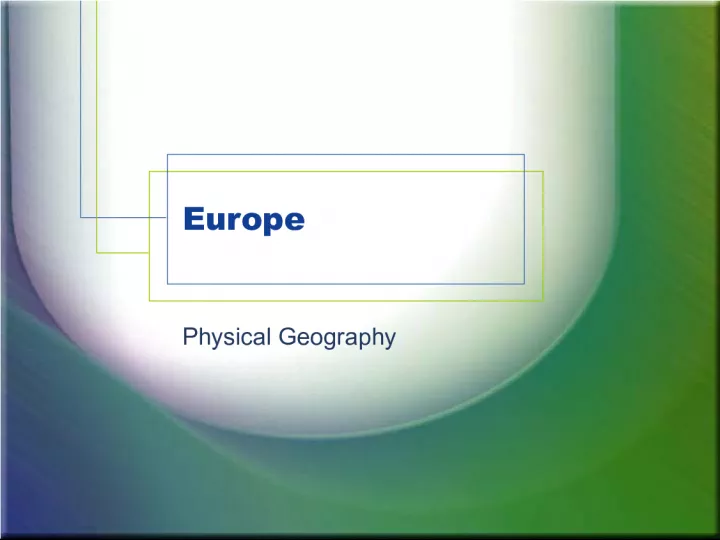Exploring Europe's Physical Geography and Boundaries


Discover the physical geography of Europe, including its location as a peninsula of Asia, its five main peninsulas, and its boundaries with Asia and the Atlantic.
- Uploaded on | 0 Views
-
 evangeline
evangeline
About Exploring Europe's Physical Geography and Boundaries
PowerPoint presentation about 'Exploring Europe's Physical Geography and Boundaries'. This presentation describes the topic on Discover the physical geography of Europe, including its location as a peninsula of Asia, its five main peninsulas, and its boundaries with Asia and the Atlantic.. The key topics included in this slideshow are Europe, geography, Eurasia, peninsulas, boundaries,. Download this presentation absolutely free.
Presentation Transcript
1. Europe Physical Geography
2. Where is Europe? Part of Eurasia (or Afro- Eurasia) Eastern border is the Ural Mountains down to Caucasus and through the Black Sea The Mediterranean Sea separates Europe from Asia The Atlantic forms the Western boundary Greenland and Iceland are considered part of Europe
3. A Peninsula of Peninsulas Europe is a peninsula of Asia There are five main peninsulas of Europe: Jutland Iberian Peninsula Apennine (or Italian) Peninsula Balkan Peninsula Scandinavian Peninsula This means that most places in Europe are close to sea access
4. Topography Southern Europe is mountainous Continues through hilly uplands Northern Europe is a broad, flat plain Good agricultural land Allowed for invaders
5. Mountains Act as a barrier between groups and climate Major mountains: Alps Separate Apennine Peninsula from Europe Tallest mountain is Mount Blanc Apennine Run length of Italian Peninsula Pyrenees Separate Iberian Peninsula from Europe Balkans Separate Balkan peninsula, breaks up many ethnic groups Act as a barrier between groups and climate Major mountains: Alps Separate Apennine Peninsula from Europe Tallest mountain is Mount Blanc Apennine Run length of Italian Peninsula Pyrenees Separate Iberian Peninsula from Europe Balkans Separate Balkan peninsula, breaks up many ethnic groups
6. Waterways A strategic waterways The English Channel Separates GB from France The Strait of Gibraltar Separates Spain from Africa The Dardanelles and Bosporus Separates Europe and Asia in Turkey
7. Climate Europe is in the middle and high latitudes, therefore, Europe has many different types of climates. In Northern Europe there are Tundra and Sub-arctic climates. Most of Western Europe has a Marine West Coast climate zone. Southern Europe has a Mediterranean climate
8. More Climate Wind currents and ocean currents have a large impact on the climate of Europe. The North Atlantic Drift is an ocean current that warms Europe. Wind currents called the Westerlies pick up warm air from the NAD and carry it over Europe, they also bring rain Farther inland, Westerlies have less impact and the climate is more harsh
9. Human-Environment Interaction THE NETHERLANDS AND VENICE
10. The Netherlands *Netherlands is also called Holland and the people are known as the Dutch. ( Im fairly sure they did this to create confusion among Geography students) 40% of the Netherlands was once underwater Dutch needed more land so they build dikes and created new land: Polders The Dutch created a freshwater lake by blocking off an arm of the North Sea in the 1900s Currently there is talk of building a 6500 foot mountain in Holland
12. Polders
13. Ijsselmeer Lake
14. Proposed Mountain:
15. Venice Germanic Tribes were invading Italy, so people fled to a lagoon Over time became a major trading center To build Venice Sunk wooden supports into the lagoon Venice is gradually sinking due to Higher sea levels Sinking supports